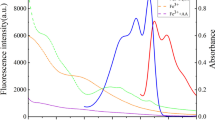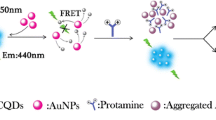Abstract
A time-resolved phosphorescence (TRP) is applied to the highly sensitive determination of Fe(II) ions. The method is based on the use of a phosphorescent probe consisting of cysteine-bridged Mn-doped ZnS quantum dots (Mn/ZnS QDs). The presence of cysteine enhances the phosphorescence of the QDs and also increases the efficiency of quenching caused by Fe(II) ions. This results in strongly improved selectivity for Fe(II). The linear response is obtained in the concentration range of 50–1000 nM with a 19 nM detection limit. Phosphorescence is recorded at excitation/emission peaks of 301/602 nm. The interference of short-lived fluorescent and scattering background from the biological fluids is eliminated by using the TRP mode with a delay time of 200 μs. The determination of Fe(II) in human serum samples spiked at a 150 nM level gave a 92.4% recovery when using the TRP mode, but only 52.4% when using steady-state phosphorescence. This demonstrates that this probe along with TRP detection enables highly sensitive and accurate determination of Fe(II) in serum.

Schematic of a novel phosphorescent method for the detection of Fe2+ ions based on cysteine-bridged Mn-doped ZnS quantum dots. The sensitivity of this assay greatly increases due to the addition of cysteine. Interferences by short-lived auto-fluorescence and the scattering light from the biological fluids is eliminated by using time-resolved phosphorescence mode.









Similar content being viewed by others
References
Que EL, Domaille DW, Chang CJ (2008) Metals in neurobiology: probing their chemistry and biology with molecular imaging. Chem Rev 108:1517–1549
Goss DJ, Theil EC (2011) Iron responsive mRNAs: a family of Fe2+ sensitive riboregulators. Acc Chem Res 44:1320–1328
Moin ST, Hofer TS, Pribil AB, Randolf BR, Rode BM (2010) A quantum mechanical charge field molecular dynamics study of Fe2+ and Fe3+ ions in aqueous solutions. Inorg Chem 49:5101–5106
Fakih S, Podinovskaia M, Kong X, Collins HL, Schaible UE, Hider RC (2008) Targeting the lysosome: fluorescent iron(III) chelators to selectively monitor endosomal/lysosomal labile iron pools. J Med Chem 51:4539–4552
McRae R, Bagchi P, Sumalekshmy S, Fahrni CJ (2009) In situ imaging of metals in cells and tissues. Chem Rev 109:4780–4827
Zecca L, Youdim MBH, Riederer P, Connor JR, Crichton RR (2004) Iron, brain ageing and neurodegenerative disorders. Nat Rev Neurosci 5:863–873
Wu SP, Chen YP, Sung YM (2011) Colorimetric detection of Fe3+ ions using pyrophosphate functionalized gold nanoparticles. Analyst 136:1887–1891
Jin Q, Hu Y, Sun Y, Li Y, Huo J, Zhao X (2015) Room-temperature phosphorescence by Mn-doped ZnS quantum dots hybrid with Fenton system for the selective detection of Fe2+. RSC Adv 5:41555–41562
Chen H, Ren J (2012) Selective detection of Fe2+ by combination of CePO4:Tb3+nanocrystal-H2O2 hybrid system with synchronous fluorescence scan technique. Analyst 137:1899–1903
Huang YF, Lin YW, Chang HT (2007) Control of the surface charges of Au-Ag nanorods: selective detection of iron in the presence of poly(sodium 4-styrenesulfonate). Langmuir 23:12777–12781
Clapp AR, Medintz IL, Mauro JM, Fisher BR, Bawendi MG, Mattoussi H (2004) Fluorescence resonance energy transfer between quantum dot donors and dye-labeled protein acceptors. J Am Chem Soc 126:301–310
Wu P, Yan XP (2010) Ni2+-modulated homocysteine-capped CdTe quantum dots as a turn-on photoluminescent sensor for detecting histidine in biological fluids. Biosens Bioelectron 26:485–490
Wu P, Li Y, Yan XP (2009) CdTe quantum dots (QDs) based kinetic discrimination of Fe2+ and Fe3+, and CdTe QDs-fenton hybrid system for sensitive photoluminescent detection of Fe2+. Anal Chem 81:6252–6257
CostaFernandez JM, Pereiro R, SanzMedel A (2006) The use of luminescent quantum dots for optical sensing. Trends Anal Chem 25:207–218
He Y, Wang HF, Yan XP (2008) Exploring Mn-doped ZnS quantum dots for the room-temperature phosphorescence detection of enoxacin in biological fluids. Anal Chem 80:3832–3837
Wu P, Yan XP (2013) Doped quantum dots for chemo/biosensing and bioimaging. Chem Soc Rev 42:5489–5521
Wang HF, Wu YY, Yan XP (2013) Room-temperature phosphorescent discrimination of catechol from resorcinol and hydroquinone based on sodium tripolyphosphate capped Mn-doped ZnS quantum dots. Anal Chem 85:1920–1925
Tu R, Liu B, Wang Z, Gao D, Wang F, Fang Q, Zhang Z (2008) Amine-capped ZnS-Mn2+ nanocrystals for fluorescence detection of trace TNT explosive. Anal Chem 80:3458–3465
Zou WS, Sheng D, Ge X, Qiao JQ, Lian HZ (2011) Room-temperature phosphorescence chemosensor and rayleigh scattering chemodosimeter dual-recognition probe for 2,4,6-trinitrotoluene based on manganese-doped ZnS quantum dots. Anal Chem 83:30–37
Liu J, Chen H, Lin Z, Lin JM (2010) Preparation of surface imprinting polyer capped Mn-doped ZnS quantum dots and thier application for chemiluminescence detection of 4-nitrophenol in tap water. Anal Chem 82:7380–7386
Jin Q, Li Y, Huo J, Zhao X (2016) The "off-on" phosphorescent switch of Mn-doped ZnS quantum dots for detection of glutathione in food, wine, and biological samples. Sensors Actuators B Chem 227:108–116
Wang HF, Li Y, Wu YY, He Y, Yan XP (2010) Ascorbic acid induced enhancement of room temperature phosphorescence of sodium tripolyphosphate-capped Mn-doped ZnS quantum dots: mechanism and bioprobe applications. Chem Eur J 16:12988–12994
Wu P, He Y, Wang HF, Yan XP (2010) Conjugation of glucose oxidase onto Mn-doped ZnS quantum dots for phosphorescent sensing of glucose in biological fluids. Anal Chem 82:1427–1433
He H, Li C, Tian Y, Wu P, Hou X (2016) Phosphorescent differential sensing of physiological phosphates with lanthanide ions-modified Mn-doped ZnCdS quantum dots. Anal Chem 88:5892–5897
He Y, Wang HF, Yan XP (2009) Self-assembly of Mn-doped ZnS quantum dots/octa(3-aminopropyl) octasilsequioxane octahydrochloride nanohybrids for optosensing DNA. Chem Eur J 15:5436–5440
Wu P, Miao LN, Wang HF, Shao XG, Yan XP (2011) A multidimensional sensing device for the discrimination of proteins based on manganese-doped ZnS quantum dots. Angew Chem Int Ed 50:8118–8121
Zhang ZF, Miao YM, Zhang QD, Lian LW, Yan GQ (2015) Selective room temperature phosphorescence detection of heparin based on manganese-doped zinc sulfide quantum dots/polybrene self-assembled nanosensor. Biosens Bioelectron 68:556–562
Wu P, Zhao T, Zhang J, Wu L, Hou X (2014) Analyte-activable probe for protease based on cytochrome c-capped Mn: ZnS quantum dots. Anal Chem 86:10078–10083
Zhuang J, Zhang X, Wang G, Li D, Yang W, Li T (2003) Synthesis of water-soluble ZnS: Mn2+ nanocrystals by using mercaptopropionic acid as stabilizer. J Mater Chem 13:1853–1857
Chen JL, Zhu CQ (2005) Functionalized cadmium sulfide quantum dots as fluorescence probe for silver ion determination. Anal Chim Acta 546:147–153
Lu Y, Yan B, Liu JL (2014) Nanoscale metal-organic frameworks as highly sensitive luminescent sensors for Fe2+ in aqueous solution and living cells. Chem Commun 50:9969–9972
Huang WT, Xie WY, Shi Y, Luo HQ, Li NB (2012) A simple and facile strategy based on Fenton-induced DNA cleavage for fluorescent turn-on detection of hydroxyl radicals and Fe2+. J Mater Chem 22:1477–1481
Yang S, Jiang ZY, Chen ZZ, Tong LL, Lu J, Wang JH (2015) Bovine serum albumin-stabilized gold nanoclusters as a fluorescent probe for determination of ferrous ion in cerebrospinal fluids via the Fenton reaction. Microchim Acta 182:1911–1916
Yang LN, Chen J, Huang T, Huang L, Sun ZH, Jiang Y, Yao T, Wei SQ (2017) Red-emitting Au7 nanoclusters with fluorescence sensitivity to Fe2+ Ions. J Mater Chem C 5:4448–4454
Xiao SJ, Chu ZJ, Zuo J, Zhao XJ, Huang CZ, Zhang L (2017) Fluorescent carbon dots: facile synthesis at room temperature and its application for Fe2+ sensing. J Nanopart Res 19:84–84
Acknowledgements
The authors gratefully acknowledge the National Natural Science Foundation of China (Grant No. 21105066, No. 21775087), Beijing Natural Science Foundation (Grant No. 2162010), Scientific Research Project of Beijing Educational Committee (Grant No. KM201610028008), and Cross-Disciplinary Research Project of Capital Normal University.
Author information
Authors and Affiliations
Corresponding author
Ethics declarations
The author(s) declare that they have no competing interests.
Electronic supplementary material
ESM 1
(DOCX 748 kb)
Rights and permissions
About this article
Cite this article
Jing, W., Lu, Y., Wang, F. et al. Time-resolved determination of Fe(II) ions using cysteine-bridged Mn-doped ZnS quantum dots as a phosphorimetric probe. Microchim Acta 185, 298 (2018). https://doi.org/10.1007/s00604-018-2813-7
Received:
Accepted:
Published:
DOI: https://doi.org/10.1007/s00604-018-2813-7




